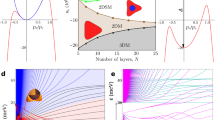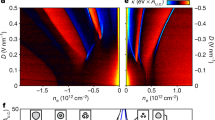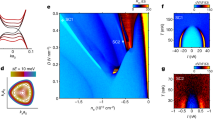Abstract
Non-trivial interacting phases can emerge in elementary materials. As a prime example, continuing advances in device quality have facilitated the observation of a variety of spontaneously ordered quantum states in bilayer graphene. Its natural extension, rhombohedral trilayer graphene—in which the layers are stacked in an ABC fashion—is predicted to host stronger electron–electron interactions than bilayer graphene because of its flatter low-energy bands and larger winding number. Theoretically, five spontaneous quantum Hall phases have been proposed to be candidate electronic ground states. Here we observe evidence for four of the five competing ordered states in interaction-maximized, dual-gated, rhombohedral trilayer graphene. In particular, at small magnetic fields, two states with Chern numbers 3 and 6 can be stabilized at elevated and low perpendicular electric fields, respectively, and both exhibit clear magnetic hysteresis. We also show that the quantum Hall ferromagnets of the zero-energy Landau levels are ferroelectrics with spontaneous layer polarizations even at zero electric field, as evidenced by electric hysteresis.
This is a preview of subscription content, access via your institution
Access options
Access Nature and 54 other Nature Portfolio journals
Get Nature+, our best-value online-access subscription
$29.99 / 30 days
cancel any time
Subscribe to this journal
Receive 12 print issues and online access
$209.00 per year
only $17.42 per issue
Buy this article
- Purchase on Springer Link
- Instant access to full article PDF
Prices may be subject to local taxes which are calculated during checkout




Similar content being viewed by others
Data availability
Original data are available in the Göttingen Research Online Data repository (GRO.data) at https://doi.org/10.25625/VXUMPN.
References
Sharpe, A. L. et al. Emergent ferromagnetism near three-quarters filling in twisted bilayer graphene. Science 365, 605–608 (2019).
Serlin, M. et al. Intrinsic quantized anomalous Hall effect in a moiré heterostructure. Science 367, 900–903 (2020).
Polshyn, H. et al. Electrical switching of magnetic order in an orbital Chern insulator. Nature 588, 66–70 (2020).
Chen, G. et al. Tunable correlated Chern insulator and ferromagnetism in a moiré superlattice. Nature 579, 56–61 (2020).
Tschirhart, C. L. et al. Imaging orbital ferromagnetism in a moiré Chern insulator. Science 372, 1323–1327 (2021).
Zhang, F., Jung, J., Fiete, G. A., Niu, Q. & MacDonald, A. H. Spontaneous quantum Hall states in chirally stacked few-layer graphene systems. Phys. Rev. Lett. 106, 156801 (2011).
Nandkishore, R. & Levitov, L. Flavor symmetry and competing orders in bilayer graphene. Preprint at https://arxiv.org/abs/1002.1966 (2010).
Zhang, F. Spontaneous chiral symmetry breaking in bilayer graphene. Synth. Met. 210, 9–18 (2015).
Geisenhof, F. R. et al. Quantum anomalous Hall octet driven by orbital magnetism in bilayer graphene. Nature 598, 53–58 (2021).
Zhang, F., Min, H. & MacDonald, A. H. Competing ordered states in bilayer graphene. Phys. Rev. B 86, 155128 (2012).
Zhou, H. et al. Isospin magnetism and spin-polarized superconductivity in Bernal bilayer graphene. Science 375, 774–778 (2022).
Zhang, Y. et al. Enhanced superconductivity in spin-orbit proximitized bilayer graphene. Nature 613, 268–273 (2023).
La Barrera et al. Cascade of isospin phase transitions in Bernal-stacked bilayer graphene at zero magnetic field. Nat. Phys. 18, 771–775 (2022).
Seiler, A. M. et al. Quantum cascade of correlated phases in trigonally warped bilayer graphene. Nature 608, 298–302 (2022).
Zhou, H. et al. Half- and quarter-metals in rhombohedral trilayer graphene. Nature 598, 429–433 (2021).
Zhou, H., Xie, T., Taniguchi, T., Watanabe, K. & Young, A. F. Superconductivity in rhombohedral trilayer graphene. Nature 598, 434–438 (2021).
Shi, Y. et al. Electronic phase separation in multilayer rhombohedral graphite. Nature 584, 210–214 (2020).
Koshino, M. & McCann, E. Trigonal warping and Berry’s phase Nπ in ABC-stacked multilayer graphene. Phys. Rev. B 80, 165409 (2009).
Zhang, F., Sahu, B., Min, H. & MacDonald, A. H. Band structure of ABC-stacked graphene trilayers. Phys. Rev. B 82, 035409 (2010).
Jung, J. & MacDonald, A. H. Gapped broken symmetry states in ABC-stacked trilayer graphene. Phys. Rev. B 88, 075408 (2013).
Cvetkovic, V. & Vafek, O. Topology and symmetry breaking in ABC trilayer graphene. Preprint at https://arxiv.org/abs/1210.4923 (2012).
Zhang, F., Tilahun, D. & MacDonald, A. H. Hund’s rules for the N = 0 Landau levels of trilayer graphene. Phys. Rev. B 85, 165139 (2012).
Lee, Y. et al. Multicomponent quantum Hall ferromagnetism and Landau level crossing in rhombohedral trilayer graphene. Nano Lett. 16, 227–231 (2016).
Zhang, L., Zhang, Y., Camacho, J., Khodas, M. & Zaliznyak, I. The experimental observation of quantum Hall effect of l = 3 chiral quasiparticles in trilayer graphene. Nat. Phys. 7, 953–957 (2011).
Weitz, R. T., Allen, M. T., Feldman, B. E., Martin, J. & Yacoby, A. Broken-symmetry states in doubly gated suspended bilayer graphene. Science 330, 812–816 (2010).
Velasco, J. et al. Competing ordered states with filling factor two in bilayer graphene. Nat. Commun. 5, 4550 (2014).
Pan, C. et al. Layer polarizability and easy-axis quantum Hall ferromagnetism in bilayer graphene. Nano Lett. 17, 3416–3420 (2017).
Geisenhof, F. R. et al. Impact of electric field disorder on broken-symmetry states in ultraclean bilayer graphene. Nano Lett. 22, 7378–7385 (2022).
De Poortere, E. P., Tutuc, E., Papadakis, S. J. & Shayegan, M. Resistance spikes at transitions between quantum Hall ferromagnets. Science 290, 1546–1549 (2000).
Zou, K., Zhang, F., Clapp, C., MacDonald, A. H. & Zhu, J. Transport studies of dual-gated ABC and ABA trilayer graphene. Band gap opening and band structure tuning in very large perpendicular electric fields. Nano Lett. 13, 369–373 (2013).
Lui, C. H., Li, Z., Mak, K. F., Cappelluti, E. & Heinz, T. F. Observation of an electrically tunable band gap in trilayer graphene. Nat. Phys. 7, 944–947 (2011).
Aoki, M. & Amawashi, H. Dependence of band structures on stacking and field in layered graphene. Solid State Commun. 142, 123–127 (2007).
Koshino, M. Interlayer screening effect in graphene multilayers with ABA and ABC stacking. Phys. Rev. B 81, 125304 (2010).
Lee, Y. et al. Competition between spontaneous symmetry breaking and single-particle gaps in trilayer graphene. Nat. Commun. 5, 5656 (2014).
Myhro, K. et al. Large tunable intrinsic gap in rhombohedral-stacked tetralayer graphene at half filling. 2D Mater. 5, 45013 (2018).
Lee, Y. et al. Gate tunable magnetism and giant magnetoresistance in ABC-stacked few-layer graphene. Preprint at https://arxiv.org/abs/1911.04450 (2019).
Zhang, F. & MacDonald, A. H. Distinguishing spontaneous quantum Hall states in bilayer graphene. Phys. Rev. Lett. 108, 186804 (2012).
Kharitonov, M. Canted antiferromagnetic phase of the ν = 0 quantum Hall state in bilayer graphene. Phys. Rev. Lett. 109, 046803 (2012).
Kharitonov, M. Antiferromagnetic state in bilayer graphene. Phys. Rev. B 86, 195435 (2012).
Bao, W. et al. Evidence for a spontaneous gapped state in ultraclean bilayer graphene. Proc. Natl Acad. Sci. USA 109, 10802–10805 (2012).
Velasco, J. et al. Transport spectroscopy of symmetry-broken insulating states in bilayer graphene. Nat. Nanotech. 7, 156–160 (2012).
Freitag, F., Weiss, M., Maurand, R., Trbovic, J. & Schönenberger, C. Spin symmetry of the bilayer graphene ground state. Phys. Rev. B 87, 161402 (2013).
Li, J. et al. Metallic phase and temperature dependence of the ν = 0 quantum Hall state in bilayer graphene. Phys. Rev. Lett. 122, 097701 (2019).
Martin, J., Feldman, B. E., Weitz, R. T., Allen, M. T. & Yacoby, A. Local compressibility measurements of correlated states in suspended bilayer graphene. Phys. Rev. Lett. 105, 256806 (2010).
Lee, D. S., Skákalová, V., Weitz, R. T., von Klitzing, K. & Smet, J. H. Transconductance fluctuations as a probe for interaction-induced quantum Hall states in graphene. Phys. Rev. Lett. 109, 056602 (2012).
Freitag, F., Weiss, M., Maurand, R., Trbovic, J. & Schönenberger, C. Homogeneity of bilayer graphene. Solid State Commun. 152, 2053–2057 (2012).
Geisenhof, F. R. et al. Anisotropic strain-induced soliton movement changes stacking order and band structure of graphene multilayers. Implications for charge transport. ACS Appl. Nano Mater. 2, 6067–6075 (2019).
Acknowledgements
F.W., F.R.G., N. F. and R.T.W. acknowledge funding from the Center for Nanoscience (CeNS) and by the Deutsche Forschungsgemeinschaft (DFG, German Research Foundation) under Germany’s Excellence Strategy-EXC-2111-390814868 (MCQST). R.T.W. acknowledges partial funding from the DFG SPP 2244 (2DMP). F.Z. acknowledges support from the US National Science Foundation under grant numbers DMR-1945351 through the CAREER programme, DMR-2105139 through the CMP programme and DMR-2324033 through the DMREF programme.
Author information
Authors and Affiliations
Contributions
F.W., F.R.G. and N.F. fabricated the samples. F.W. and N.F. conducted the electrical measurements with the help of A.M.S. and F.R.G. F.Z. developed the theory. All authors discussed and interpreted the data. The paper was written by F.W, F.Z. and R.T.W., with input from all authors.
Corresponding authors
Ethics declarations
Competing interests
The authors declare no competing interests.
Peer review
Peer review information
Nature Physics thanks the anonymous reviewers for their contribution to the peer review of this work.
Additional information
Publisher’s note Springer Nature remains neutral with regard to jurisdictional claims in published maps and institutional affiliations.
Extended data
Extended Data Fig. 1 Ferroelectric states.
a,b, Map of the resistance difference between forward and backward sweep of the electric field as function of electric field and charge carrier density at B = 3 T in a and B = 8 T in b. The region with vanishing conductance at zero density has been removed due to large resistance variations to enhance visibility.
Extended Data Fig. 2 Quantum Hall states at low magnetic fields.
a-c, fan diagrams of the conductance derivative with respect to the charge carrier density of device A2 (cf. Supporting Table 1) at E = 0 mV nm−1 in a, E = 24 mV nm−1 in b and E = 47 mV nm−1 in c. The filling factors and their corresponding slopes are indicated on the top of each panel. The roman numerals indicate the associated spontaneous quantum Hall states, namely the LAF/CAF state (I), the ALL state (III) and the QAH state (IV). d-f, Fan diagrams of the conductance derivative with respect to the charge carrier density of device B1 (cf. Supporting Table 1) at E = 0 mV nm−1 in d, E = −20 mV nm−1 in e and E = −60 mV nm−1 in f. The filling factors and their corresponding slopes are indicated on the top of each panel.
Extended Data Fig. 3 Device schematics.
a, 3D view of a dual-gated trilayer graphene device with a silicon bottom gate and a gold top gate. b, Cross section of the device shown in a along the graphene axis.
Supplementary information
Supplementary Information
Supplementary Sections 1–6, Figs. 1–5 and Table 1.
Rights and permissions
Springer Nature or its licensor (e.g. a society or other partner) holds exclusive rights to this article under a publishing agreement with the author(s) or other rightsholder(s); author self-archiving of the accepted manuscript version of this article is solely governed by the terms of such publishing agreement and applicable law.
About this article
Cite this article
Winterer, F., Geisenhof, F.R., Fernandez, N. et al. Ferroelectric and spontaneous quantum Hall states in intrinsic rhombohedral trilayer graphene. Nat. Phys. 20, 422–427 (2024). https://doi.org/10.1038/s41567-023-02327-6
Received:
Accepted:
Published:
Issue Date:
DOI: https://doi.org/10.1038/s41567-023-02327-6



